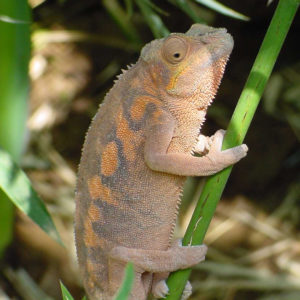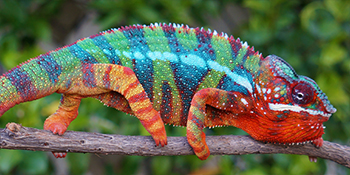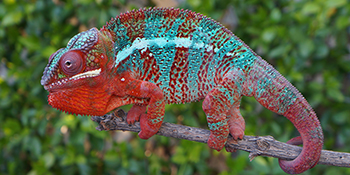Chapter 1: Choosing Your Panther Chameleon
The first chapter in this story is Choosing Your Panther Chameleon! Here I talk about what we need to know when we are choosing our panther chameleon and a breeder. This is the start of my journey. I presently work with the Ambanja locale and am ready to add a color from the opposite end of the spectrum. In this chapter, we will do the following:
- Review the Panther Chameleon species
- Choose a locale of Panther Chameleon
- Evaluate Breeders
Using what I share here I will make a decision as to the breeding stock and select reputable breeders. The guidelines I present here are just as applicable whether you are looking for a single pet chameleon or the start of a breeding project.
Chapter 1: Choosing a Panther Chameleon Video Episode
The following video is from the Chameleon Academy YouTube channel where I have educational videos about a wide range of chameleon topics. This page will embed the videos specifically part of my Panther Chameleon story. To subscribe to the video channel to see all the videos go to YouTube and hit the subscribe button. Also, hitting the bell icon makes sure you are notified when a new video is released. Click here to go to the Chameleon Academy YouTube channel.
Chapter 1: Choosing a Panther Chameleon Podcast Episode
Where the video is more of a digital diary of my personal journey, the podcast dives into more detail. You can listen to the episode here on the website in the player below. You can also listen to it on any standard podcast player. The ideal way to access the Chameleon Academy Podcast is through the dedicated app that is available on both the Apple iTunes store and the Google Play store for Android mobile devices. Either click the links for the store or just search for “Chameleon Academy” and look for the rainbow panther logo!
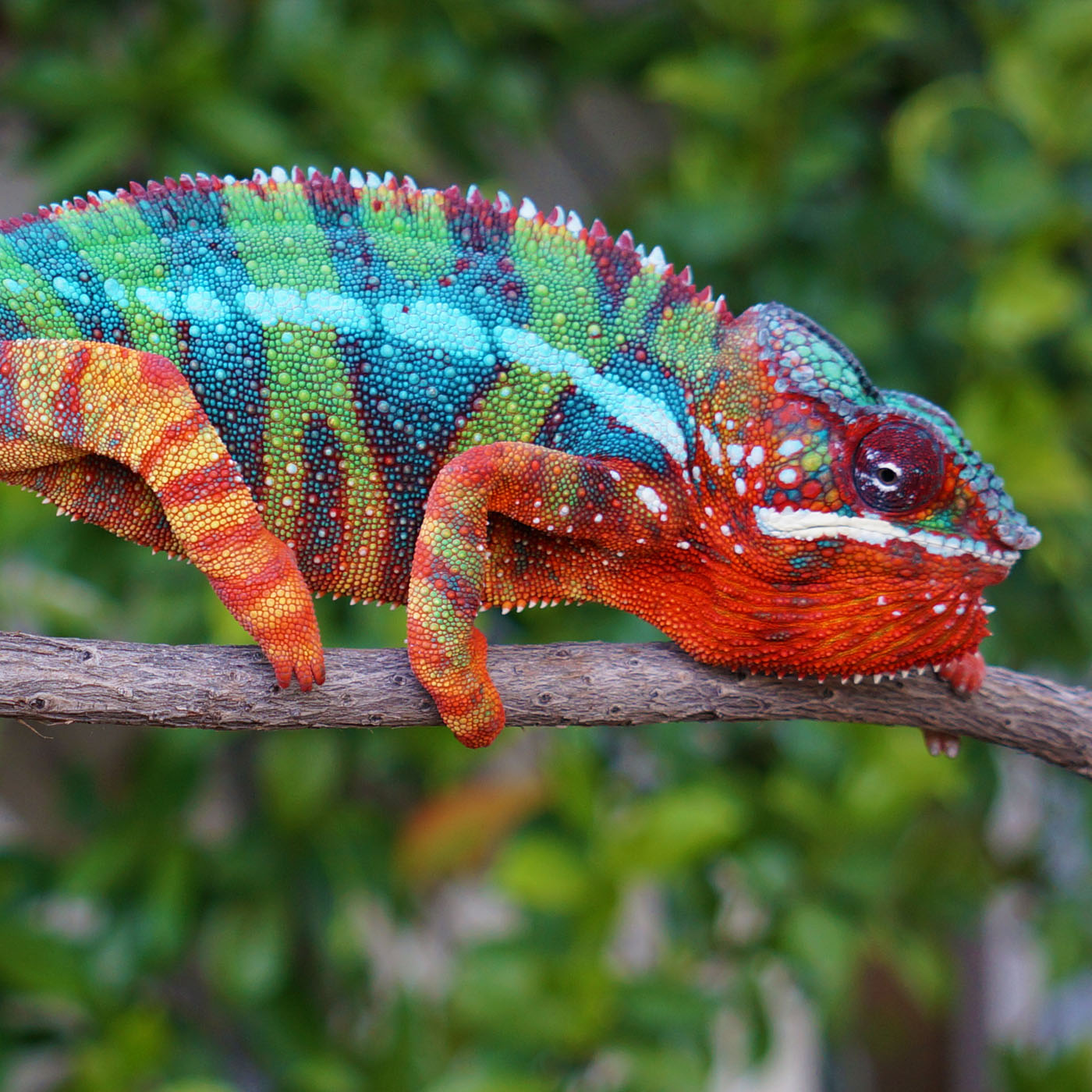

Bill Strand
Selecting Your Panther Chameleon
Introduction to the Panther Chameleon
Panther Chameleons are the most commonly bred species in the chameleon community. Their bright colors make them instant favorites. A Panther Chameleon is the perfect first chameleon due to their appeal, hardiness, and wide support network.
Natural History
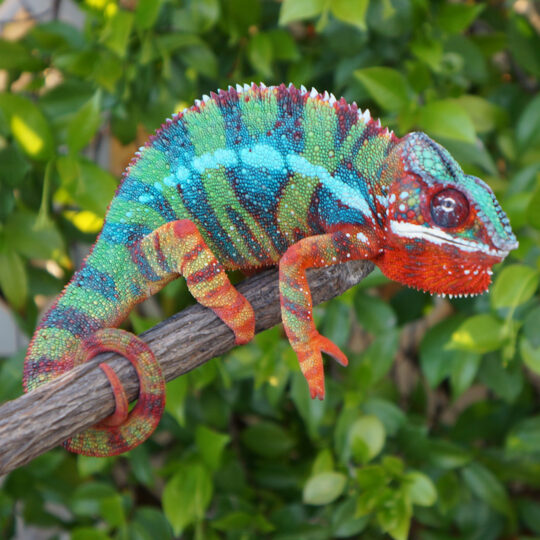
Furcifer pardalis, the panther chameleon, is widespread along the coastal regions in the northern third of Madagascar. It inhabits the lowlands and islands. Panther Chameleons have the characteristic that each locale has a distinctive coloration. Almost the entire rainbow of colors is represented in panther chameleon locales. Although purple has been difficult to find in the wild, it has come out in captive breeding – so the genes are there!
The males are larger than the females and brightly colored. The females are an overall orange/peachy color, though, when gravid can become a deep black with orange stripes.
The community has identified the different morphs by their locale. Names such as Nosy Be, Ambanja, and Ambilobe are locations in Madagascar that you may visit.
Selecting Your Panther Chameleon Type
Locales
Now let’s turn our attention to the different colors of panther chameleons. Nobody knows what is up with panther chameleons and their different colors depending on where they are found on Madagascar. They even loosely transition from hot colors to cool colors as they start on the central Eastern part of Madagascar with reddish colors and follow the coast in a counter clockwise rotation around Madagascar until you get to the blues in the North Eastern area. Why did this system set up like this and why do they not mix in areas where they geographically could? I do not have answers for you. But, the good news is that we don’t have to know why to enjoy what is. Yes, there is an amazing array of colors available from warm reds and yellows to cool greens and blues. Even bright bubble bum pink! When you hear names like Ambanja, Sambava, Ambilobe, or Nosy Be, these are all towns in Madagascar that are in the vicinity of where the particular panther chameleons are collected.
Breeders in the community are pretty passionate about keeping the locales separate. They can interbreed, but the result is not always the bag of skittles you hope it will be. It is often akin to combining crayons. Remember mixing all those colors in grade school? It can be kind of a dark mess. But once there is a genetic cross like that you cannot get the locales back out. It is forever gone. So we like to keep them separate in our breeding programs. This is why breeders specialize in their own selected handful of locales.
As for which one you should pick, this is to personal taste. What color palette do you enjoy most? I’ll leave that to you to mull on your own. People have literally spent hours outside panther chameleon booths at reptile shows agonizing over this decision! And while you do that I want to share some thought points on color
- It is the males that show the eye popping color. The females are beautiful as well, but are pinkish orange salmon.
- Colors start to come in between 4 and 6 months and will continue to mature passed the one year point. They stabilize in adulthood, but do continue to shift through their life.
- The colors you are so used to seeing on males are actually their fired up colors. Your panther will not be this way at rest – and you don’t want them to be that way at rest! You want them in their calm colors. They will still have attractive colors in their calm state, but don’t expect the knock-your-socks off effect 24/7
- Every panther is an individual. Lineage gives you a good idea what you will receive. The longer the lineage the better the clue. But no one can guarantee what your juvenile will look like as an adult. So, if a specific color is important to you then limit your search to established breeders with history. It isn’t a guarantee, but you are stacking the odds in your favor. The females genetics are just as important as the males so take a look at the female’s father as much as you do the direct father.
- When your panther looks washed out and dull, consider whether it is starting a shed before you panic.
Mixing Locales
And now we can go back and understand the lukewarm response to the feral population of panthers in Florida. It appears these are mixed locale panthers. And, even if one shows up appearing to show the classic colors of a certain locale, you could not be sure that there wasn’t a cross somewhere. We essentially have a special Florida locale.
There are a few breeders that have put the work into developing a line of mixed locale panthers. These panthers can be amazingly beautiful, but realize it took a great deal of work to selectively breed them so they would be beautiful to our eyes. I got a mixed locale once from two attractive parents and it looked like mud. I don’t know, maybe on the UV spectrum he was radiant. But on the human visible spectrum the color combo just didn’t work.
There are always breeders that just want to breed panther chameleons and don’t care about locale and some pet stores just don’t care about locale so you will run across ads or Petco where you are buying a “panther chameleon” with no locale information. If you know you will never want to breed them in the future then they make just as good of pets as any locale so I am not suggesting a blanket ban on them, but please don’t cross locales yourself. And this is also for your good too. Crossed locale panthers will be much more difficult to sell – especially a female. Many people purchasing females want to breed them and much of the customer base is savvy enough to check lineage and will shy away from mixed locale females. And since it is unknown how the males will look you may end up having to keep them until they grow up, which you won’t do so you end up selling them wholesale to a pet store. So, selling the babies will be much harder for you. As with any breeding program. If you are going to breed, start off with the best genetics. It doesn’t cost any more to raise up pure locale babies and you’ll have a much better time of it.
Male vs Female
You will also have a choice between male and female. Obviously, the males are more popular because of the incredible colors. But, don’t discount the females. I always like to say that the females are spectacular themselves with pinkish, orange, salmon colors. They are overshadowed only when placed next to a male. They make delightful pets in their own right. I have loved my female panthers and there have been times I have had only female panthers. If you are considering a pet, then a female is just as good of a candidate as the male.
Locale image gallery
Every location of panther chameleon seems to have a different palette of colors. There are no significant differences in husbandry for the locales imported. Though it would be interesting to find out if animals collected in the upper elevations would require a nighttime drop or if the entire species merely has tolerance from o to 950 meters above sea level. Shown below are only a hand full of the different morphs!

Male wild caught from the island Nosy Be showing the variation that can be found.

Some individuals on Nosy Be were almost all blue. This is an F1 panther from blue wild caught parents. Not every baby in this clutch was all blue. This image was taken in 2001. Since then the blue color has been refined and is now reliable in certain captive lines.

A chameleon from the Ambilobe area.
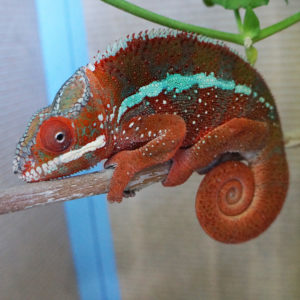
An unnaturally red individual from Ambilobe parents.
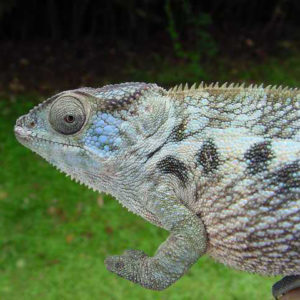
Some females tend toward the gray side, though this is not a reliable method of telling locale.
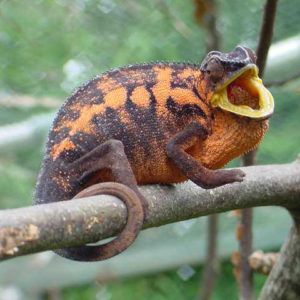
When gravid, females of all locales will turn black with orange stripes to warn males that they are not receptive.
Personality
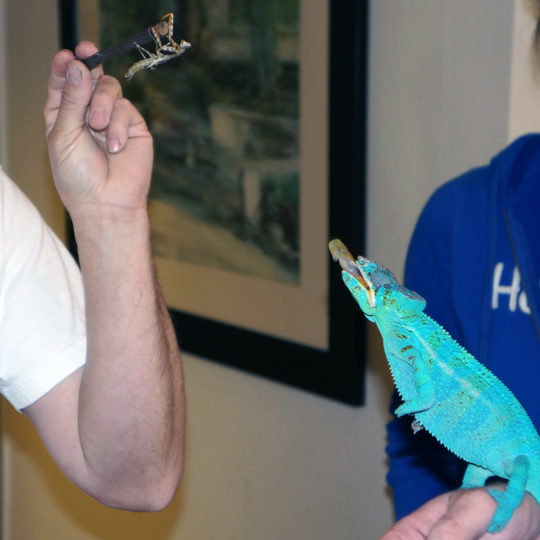
Panther Chameleons have definite personalities. They can be shy, outgoing, or even friendly. They are highly intelligent as far as chameleons go and will learn your schedule and develop expectations surrounding meal times if you are consistent.
For the most part, panther chameleons will calm down enough to be handled without much drama. They are chameleons so handling should be kept to a minimum, but Panther Chameleons have a respectable tolerance for us humans.
Each panther chameleon is an individual so you’ll have to judge them for who they are. I have had some that were prone to biting. Though this is done in defense and to get away. You will get warning signs before there is a bite. The bite of an adult can break skin, but there is little damage to brag about. Your boa keeping friends will not be impressed.
Selecting Your Panther Chameleon Age
Wild Caught
First, let’s address the standard question about Wild-caught vs captive hatched.
In 2021, you are unlikely to run into wild caught chameleons from Madagascar. They occasionally come in, but are usually snapped up by breeders. And this is fine. Starting out, you want the experience of raising up a baby. It is incredibly fulfilling. I know we tend to want the immediate fulfillment of having this brightly colored beast slinking around the room, but, honestly, even if you do get an opportunity to buy an adult, I strongly encourage you to not cheat yourself of the experience of getting a well started baby and watching him or her grow up and grow into his or her colors. It is truly one of the most fulfilling parts of chameleon keeping.
Keen-eyed readers will note that I added on “from Madagascar” when talking about wild caught Panthers. There is a wrinkle to this and something to watch out for. It is hazy exactly how this happened, but there is a population of panther chameleons that are in Florida and these make their way into being sold to the pet market. The issue with these is that you cannot necessarily determine locality and they are most likely mixed. We now have a Florida locality of Panther Chameleon. If you are looking for a pet, these may come to you in good condition, but I will still encourage you to go for a captive hatched panther. We will get into locales very soon so you can understand the complications and make an informed decision.
Juveniles
By far, the most common form you will find panther chameleons is as three+ month old juveniles that are shipped to you from a breeder. With the mature panther breeding community we have in place, you are able to choose locale and get a lineage for the baby. So you can select not only a baby, but view the parents and grandparents. There is one breeder that can offer you beyond ten generations of lineage. Every chameleon is an individual, but you can get a pretty good idea of what they will look like.
With a solid breeder infrastructure comes solid husbandry help. You now can interface with someone who is doing this as a substantial side business or even as their primary business and with that comes increased ability to offer customer support. You can safely choose to have a panther chameleon be your first chameleon or even first reptile pet and the support structure from the breeders and multiple social media sites will be there for you to lean on. This is the safest way to start with chameleons.
Since you are selecting a juvenile by lineage you may have to wait for a clutch to hatch and be ready for sale. Consider this all part of the fun. More importantly, this gives you the opportunity to get your cage and equipment in, set-up, and running. So it is ready for your chameleon to come home.
Eggs
With Panther Chameleons you actually have the option to have eggs shipped to you. Many people see this option on eBay and the price is quite attractive. You have no idea whether you will have a male or female, but, reading the description, it sounds pretty easy to do. This is a touchy subject with many passionate opinions ranging from it being better to ship an egg rather than a live chameleon to it being unethical to sell eggs. Feelings run high on this so if you start or join a discussion online – hold on tight. I’ll give you the high level considerations. You are sent an egg to finish its incubation. Assuming the egg is fertile and healthy, this is really not that big of a deal. Standard room temperatures in the low to mid 70s are effective for incubation. Once the baby hatches you just have to be ready for a chameleon in the miniature.
Sounds simple…what is the controversy? Well, chameleon babies are sensitive to raise up and so may be a challenge for someone getting used to chameleon husbandry. There is a reason why we chameleon breeders wait three or so months to send you a well started baby panther. By three months old they are actually easy to care for and have a certain tolerance range that can allow for small husbandry lapses. A hatchling, on the other hand, doesn’t allow much buffer. Once they show signs of sickness it is hard to bring them back.
So, should you consider buying an egg? I’d say be careful with that. Personally, I don’t think that shipping an egg to a customer who is fully aware of what they are getting is unethical, per se. In my opinion, the major concern is whether you are ready to take a baby from hatching. There are challenges to raising up a baby chameleon. Now, there are resources to tell you how to do it so technically, you could study up on it and make it work. And if you found a seller that would provide mentorship and you got everything ready ahead of time it could work. So I am going to say proceed with caution. Consider buying an egg only along with diligent study into husbandry of chameleon babies. The information that came along with a test a friend of mine did was sparse. I can’t speak for everyone so maybe here is someone out there that has better support. And, warning, just be ready for the backlash if you share what you have done on social media. Support for shipping eggs is running low at this time.
Selecting Your Panther Chameleon Source
Breeder
We are lucky that there are number of breeders to choose from. The breeder community is pretty strong and the number one choice for getting a panther chameleon is to get a juvenile from a reputable breeder. Honestly, that is the first seven choices. All other options are way down on the list. The Panther Chameleon is the one chameleon where reputable breeders are easy to find and there is usually availability within months of you making the decision. This is because, once a clutch hatches, you can reserve your place in line while the experienced breeder makes sure the baby is strong and vigorous by time it is ready to go to its new home.
I know, in this Amazon inspired world, our desire to have something the minute we decide on it is strong, but getting a chameleon is the right time to slow it down and plan. In today’s world there is a good chance you will be on a waiting list for the genetic line you are interested in. This is a good thing! This is worth it. Get the genetic look you like. A few months wait is a drop in the bucket compared to the number of years you will be mesmerized by the incredible colors. The very beneficial side effect is that you now have time to get the equipment and put together your cage. This podcast is being released during the Covid era where supply chains have been disrupted and product flow isn’t as predictable as before. But Covid or not, you’ll always run into unexpected delays here and there. So having a few months to make sure everything is in place is a great plan. Just plan it that way – as having the cage up and running with bugs worked out before getting your chameleon – is the absolute best plan.
Finding a panther chameleon breeder is not hard. A google search or an afternoon on any social media will provide many options. Selecting a reputable breeder takes a little more digging. I have to warn you that coming up first in a Google search is not an indication of quality. It is often a factor of being web savvy which has nothing to do with panther chameleon breeding. You can use the first couple pages of a Google search to get you names to check out, but look into it. I did a search and noted some names I would definitely not recommend come up high in the list. Asking about them on chameleonforums.com, Facebook, or any other gathering of chameleon people would bring out how well they are viewed in the community. Although I also have to caution to be careful about what you read on social media. It is a great place to quickly connect with lots of people, but dig deeper there too. People with an axe to grind love to go on social media and air their grievances. Every business has their handful of haters who take it upon themselves to throw mud every possible opportunity. Happy customers usually just spend their time enjoying their panther chameleon. So, where ever you are researching, dig beyond the first layer. You’ll start seeing patterns. The most glowing review may be their mother and the worst review is the customer that tried to take advantage of them and got their feelings hurt. See what the middle has to say. Here are things to check for in your own research. And, remember, none of these items are an automatic strike out. They all just add together and give you an overall feeling for your choice.
- How long have they been in business? The longer they have been in business the more established, and proven, their breeding lines will be. The longer they have been doing this the more likely they will have their act together and have their husbandry methods figured out. Obviously, with the great information that is out there, it is not hard to start a business and do it well from the start. As long as you are a good breeder you can hit the ground running. So, a new breeder is not a full stop. But, there is less track record. You have panther breeders who have been doing this for a decade or even two. There are long term options out there.
- How far back is their lineage? The best way to be sure you have consistent colors is to only use the right males and females for that color. This is tricky because females cannot be distinguished among the locales. So, to be accurate, the females have to be proved out. This means get a clutch from them and grow up the babies until they can be observed in adult colors. This takes time and resources. And then, when adding in the future bloodlines, you keep the well-known female line and add in males who you can see their colors. So the males are the focal point, but bloodlines are often kept through the females.
- Are they active on social media? This is not a sign of whether they are good, but just an opportunity that you have access to their philosophies, possibly their husbandry, and how they interact with people. This is not a sign of the quality of their chameleons. Anyone can be active on social media. In fact, before Facebook cracked down on animal sales, we had so many Facebook breeder pop up because it was so easy to make a logo and open up a page. It was sad and laughable to see beginners memorize all the talking points, open up a shop and call themselves breeders before their first clutch even hatched. So be aware how easy it is to memorize husbandry and talk about it as if you are the expert. It happens all the time. And people new to the community can’t tell the difference between people who know what they are talking about and people who desperately want people to think they know what they are talking about. So, social media is a great tool, but please use it with caution.
- Do they have a website? This can be a sign of how established the business is and how easy it will be to research the lineage. A new breeder or someone just doing this for fun won’t have the digital footprint of a long time breeder. Once again, a good breeder that invests in top notch genetics and produces one clutch every now and then can provide just as good of a chameleon as any established long term breeding business. But it means that it is worth doing a little bit more digging to determine whether this is a good pairing or if this is some guy who grabbed cheap panthers from Petco and isn’t sure of where the female came from. A website gets a breeder points because they have invested more into establishing a digital footprint than say, a Facebook page. This is not a sign of quality of product, just a sign of commitment. Like I said, there were a few websites that popped up on my Google search that I would not recommend at this point in time. And, once again, I am avoiding mentioning names because I want to focus on sharing tools to be an informed consumer. All the names are constantly changing. But if you learn how to identify quality and ferret out the fly-by-night breeders then it doesn’t matter when you listen to this episode, you can use the information with the cast of characters that are active at the time of you listening.
- When you call them can you talk to someone? This is important if you would like to get support. If this is your first panther chameleon then support from the breeder is probably very important. Call them up and talk with them. See if you both click. Me? I have been doing this for so long I don’t want to talk with anyone. Allow me to select from your website and leave me alone. But, you are young and fresh and innocent in the chameleon world. It is good to make friends. Bah humbug. I am going back to my chameleon room.
- Do they have a facility? Visiting or seeing pictures of how they keep their chameleons is a great way to get a feel for their husbandry. This is a tricky thing as there are a number of legitimate reasons why a breeder will not want to share their inner workings. Unfortunately, there are intense politics in the panther chameleon world and some breeders are careful at sharing anything that would provide fodder or information for competitors. But there are some breeders that have made their facility and their openness a focal point for their sales. Add this to the mountain of information you are gathering.
This all sounds like a lot of work. Isn’t it simplest to get a bunch of names by googling or asking on Facebook for breeders and then seeing if you like what is on their website or not? Well, yes, you can make it as simple as you want. But I just got an email from a listener that is taking this whole process very seriously. She is getting her entire set-up together two or three months before she expects to get her baby. She is deep researching breeders and sources. And she has already ruled out two sources for very valid reasons. One is selling babies too young and the other has multiple females with a male cohabitating and stuffed into cages too small. It is possible that a baby coming from these origins could grow up to be a fine pet. But why take that risk when there are so many reputable breeders to choose from?
And here is where we have to talk about the dark side of the breeder community.
The great thing about panther chameleons commanding a high price is that serious breeders can put in serious infrastructure and resources to do it right. This is a good thing and we will be able to have good quality panther chameleons as long as the price remains high enough to support this investment. The downside to the high price is that it provides a tempting incentive for breeders without high standards to try and make some money. Panther chameleons breed easily and will do so in even substandard conditions. You can get eggs by keeping a male and three females together in a cage. Heck, increase your production by putting three females in with a male! You harvest the eggs until the stressed females burn out and you just replace whatever drops dead. The parents live short, stressful lives, but, yes, eggs will be produced. By all appearances, the babies that hatch look like any other, but they were produced by stressful conditions so it is unknown what kind of strikes against their health they are carrying.
This is why you do not want to price shop panther chameleons. Regular listeners of the podcast are probably getting tired of hearing me say this! But it is something we all need to be constantly pounding into the community until it is just accepted. Do not price shop for chameleons – quality shop. This does not mean you automatically go for the highest price. I am sure there are breeders that would love to accommodate you if that is how you shop. But, I mean look into the breeder, learn what their breeding philosophies are, see pictures of their set-up if possible, and pay whatever the price is of the breeder that meets the highest husbandry standards. That is what I mean by quality shop. Reputation is important. Gravitate towards breeders that have a good reputation. If all of us are willing to put our money where our mouth is and support breeders we know are treating their animals with the high level of care then that is the community we will create. Seriously, we are 100% in control of the community. If we insist on the cheapest prices, then that is what businesses will survive. If we only buy $200 panthers, then we will only get panther puppy mills as that is the only thing that $200 will support. It may sound like a lot of money, but once you raise up a clutch of baby panthers you will be surprised at how much it costs to do it right.
Pet store
Pet stores are another source. Panther chameleons make it into the Petco/PetSmarts of the world and they are a regular at reptile specialty stores. At the big box stores, you often won’t be able to be sure what you are getting as far as locale. While you may get lucky and get the quality overflow from a major breeder who had to sell off excess inventory, you could just as likely get a mixed locale. These should all make just as good of pets as any other, but if your reason for getting a panther chameleon is the colors then don’t cut corners and just spend the money for exactly what you want. Consider this a five to 7 year relationship. You will not regret investing in exactly what you want. Health of chameleons is hit or miss at pet stores. It all depends on how healthy the chameleon came to the pet store and how good the reptile section manager is. Some are incompetent and some are excellent. Just know what to look for in a healthy chameleon when you go in.
Reptile Expos
And a word on Reptile expos. You can find good deals there. You will find the good and the bad breeders right next to reputable and shady importers so it really doesn’t hurt to do your research ahead of time from the vendor list. It really is the same as buying online except that they usually bring stock to sell right there so it pays to buy all your equipment months before hand so it is ready. Of course, most people buy everything at the show and take it home so, yeah, that works too. Just not as well! I am here to share best practices, but know actual execution is not always perfect.
While we are on the subject of Reptile shows I’d like to warn you of a trick I see played on people getting their first panther chameleon. And I hate to say I have heard it more than once. The vendor will convince you to buy a female for your male with the lure that you can become a breeder and make back your money and more. There are so many things wrong with this scenario, but it is so enticing that people go for it. I will not go into the pitfalls of thinking you can make easy money by breeding panther chameleons. And, yes, the pitfalls are many which is why more people aren’t doing it. What I need to address is when they try to convince you to buy a female and say you can keep her in the same cage as the male. Or say that females can be kept in cages together. This is disturbing because breeder trying to increase their production will use females as egg machines and keep two or three in a cage together. Yes, you can do this and the females will lead a stress filled shortened life . But if the breeder buys into the old thought that females only last a couple years and are meant to pump out eggs then it is certainly meeting the breeder’s goals, isn’t it? But I would like you to look higher. Don’t treat the female as an egg machine. Give her her own cage and long life. Yes, laying eggs is part of biology and she will be able to do this with no problem. But give her her own cage. This is proper chameleon husbandry and I encourage you to avoid any chameleon business that suggests to you that you can keep chameleons together. I know they can be as babies, but when they are old enough to go home with you they are old enough to need their own cages.
Panther Chameleon Community Topics of Discussion
Politics of husbandry
First is husbandry. There are many approaches to husbandry. And it would be fine if everyone who actually proved out a husbandry routine would be content to present it and not care how others do it successfully. Sorry, our community is much more soap opera than that. Warring tribes on social media have staked their claim on there version of the truth and do not care whether evidence supports or refutes their selected mindset. Without going into the rabbit hole on this, I want to warn you that social media groups have no problem criticizing breeders that have ten times the experience that they do. Do not get confused if your select social media group directly contradicts what your breeder told you to do. Now, I never understood why people will throw away the husbandry that an experienced breeder has proved out for generations of panther chameleons in exchange for a Facebook admin that has a tenth of the experience. I really don’t get it. It doesn’t take anything to become and admin. Remember that. There are admins with exceptional depth of experience and there are ones that are a friend of a friend. Stop assuming social media teams know enough to replace what a reputable breeder does. Yes, there are different approaches. And here is a hint. If the approach didn’t work, the breeders wouldn’t be doing it. Sick and dying breeding stock is a very business killing event.
And yes, I am a Facebook admin. Yes, I advise a husbandry routine that is different from a number of the most successful breeders. And, yes, I both have tested mine and respect that their’s has been tested as well. None of us has the ultimate truth! We are all working to figure this out. You’ll find fights over what supplementation to use, what UVB configuration to use, and whether screen cages are the one and only acceptable caging. And these will continue to rage on and on. They wouldn’t if everyone was working off of evidence and testing, but they are not. There is a great deal of emotion and ego involved. Does this sound like a whole lot of complication you really don’t need in your young chameleon keeping life right now?
Good. Then just embrace this bottom line. Decide who you want to listen to and don’t get second or third opinions unless you are prepared for completely opposite responses that say you are killing your chameleon. I suggest you research your advisors just like you do your breeders. How long have they worked with panther chameleons? How many generations have they raised? You will be shocked how shallow many social media expert’s experience is. You are welcome to decide which voice you will listen to, but if you start taking advice from another group don’t come back to the breeder asking why your chameleon needs help. Go to which ever group you have decided to listen to. Because, these different opinion groups have figured out how to make their way work and so they are experienced in troubleshooting their way. They are not experienced in troubleshooting other people’s ways. This is where the Facebook group I work with, The Chameleon Enthusiasts is unique. We use the Chameleon Academy way to teach beginners who do not already have a baseline husbandry, but the team has made the effort to be knowledgeable in the different approaches of panther chameleon breeders and can help you with the method you have been shown by your breeder. We can help you tweak things in your selected husbandry method without requiring you to switch everything out to match our beginner method.
Price
One thing I hear often from people looking for their first panther chameleon is a exclamation about the price. Yes, panthers can be anywhere from $300 to over $500 and close to $1000 for prized rare locale males. Bu this high price is the reason why you have such good choices available to you. If they were $200 then no one could afford to be serious with them and they would be available through hobby breeders that would come and go as their attention faded. The prices ensure that all exports could cease and we would have panther chameleons available to us for many years. Notice how most chameleon species disappear once imports stop? That is because it isn’t worth breeding them. Yes, I know, we should all love our hobbies. But a breeding project takes more than just being a hobby. You need bloodline diversity, time, and are constantly pouring in financial resources. If it is always a loss then people simply won’t continue doing it once they have had their fun. Of course, the price is not driven by some altruistic force wanting to establish the species in captivity. It is simple supply and demand and there is little control we have over it beyond being our part in the market forces. I am actually looking at expanding my work with panther chameleons beyond the Ambanjas I have now and I will be gladly paying full price for the best genetics.
Fx vs CGx
Finally, there are generational designations you see describing the lineage. There are two designations, the Filial number and the Captive Generation number. The Filial number is that F1, F2, F3 number. This is to designate how far your panther chameleon is from having wild blood. If a father or mother is wild caught then the baby is F1. It is one generation from wild blood. It doesn’t matter how many captive generations the other parent is. You could mate a wild caught male to an F10 female and the baby would be F1. You can only graduate to F2 if one of the parents is F1 and the other is F1 or greater. So, you see how the Filial system tracks the parent that is closest to the wild?
This doesn’t work well for panther chameleons. That is because we have to prove out our females and we structure our lines around the females. A wild caught female is a wild card. We have no idea what locale she is. We know that exporters in Madagascar either accidently or deliberately mislabel females because they know they can get away with it. If someone orders 100 ambilobe females and the exporter has only 80, but they have a bunch of Ambanja females they aren’t going to go through the expense to get another 20 Ambilobes, and they would hate to lose out on the profit of those 20…and Ambanja isn’t really that far from Ambilobe and so you can see what may happen. So a reputable breeder will get a clutch from that female, raise it up, and verify it is the locale expected before selling the offspring as Ambilobe. And this is self-preservation. If a bunch of customer complain that your Ambilobe is actually an Ambanja cross that throws all the eggs you have collected from that female into question and there is a serious hit to the trust in any of your pairings. How many others have you done this with they wonder. So a proven female is a very valuable chameleon. So the females a proven female produces will continue the line. Because it is easy to find an unrelated male to bring in. And by easy I mean it is easy to tell the locale of the male and he can be productive right away without the long proving out process. So say you bring in a wild caught male for every successive generation. The offspring are always F1 because the male is always wild caught. But the females may have been five generations in. This means that the confidence is sky high that you are getting an Ambilobe. But if you see F1 that baby could easily be from an unproven wild caught mother. This is why we came up with the CG, or captive generation designation. A fifth generation female mated to a wild caught male would produce F1, CG6. And this communicates the value of the genetics. A wild caught male which brings in strong wild genetics, and a fifth generation mother designating the confidence in her genetics. So if you see a CG number along with the Filial F number that is what is being communicated.
Just some background, the CG system is something I proposed on this podcast back in episode 14 to solve our problem. It has been adopted by at least one panther breeder and, actually, at least one gecko breeder. But it started here on this podcast so don’t expect anyone outside the chameleon community to know what you are talking about. It is a very useful tool to accurately communicate the genetic mix so I hope it gets more widespread use.
Now, no system is perfect. You can see how you could get an F1, CG 5 rating by mating a well known 4th generation male with a wild caught female. And that isn’t a pairing with the amount of confidence the CG5 would suggest. So, like everything human hands touch, there is a way to mess it up. As always, it is important that you are working with a breeder you have high confidence that they know what they are doing and care about their work. Reputation is worth so much more than the lowest price.
I could be a Panther Chameleon breeder!
The final thought I would like to discuss is what often crosses people’s minds when they are looking for a panther chameleon. And that is that, hey, I could be a breeder! With these prices I could make a living doing this! So, There are very few people who do this full time. More people do it part time. But there are very good reasons why more people aren’t doing what they love. The challenge comes in raising the babies. Baby chameleons do not like to be together and so raising a clutch of 30 babies requires serious infrastructure. Ideally, 30 cages. But most breeders cut that corner (but not all, by the way, so don’t think it can’t be done). If you keep them in small groups it can work, but you have to keep a close eye on them and separate when there is trouble. And you have to do this for three months while they get larger and more aggressive. I can go on a major reptile retailer website right now and find B grade panther chameleons with nipped tails for a discounted price. Do you know what these are? These are babies that had their tail tips bitten off by cage mates. Chameleons do not like being kept with each other. I keep saying that and people think I am just cranky. No, really, I say that because it is true! I wish it weren’t true! Sure, nipped tails do not affect health and bite marks disappear after a couple sheds, but do you see how having 30 panther chameleons in a bin gets to be a real stressful situation for you as they all turn on each other? Oh, and what happens when you have clutches where hatching overlaps? You are now taking care of multiple clutches of babies who could turn on each other at any time. Well, some clutches don’t. But some do.
I have this thing where every time I hear someone brag they have 300 eggs in the incubator I predict that is the last we have heard of them and it is true more often than not. It is easy to get eggs. What destroys breeding projects is having more babies than you can handle at once. The stress really sucks all the joy out of it. So, you may have these thoughts. They are good thoughts. Keep them in the back of your mind and go slow. It can work, but really get your experience under your belt before you are tempted to just get a pair and try.
Conclusion.
Selecting a panther chameleon is one of the most exciting things that will ever be on your to do list. Like I said, it is now on my to do list and I am as excited as I was 30 years ago getting my first panther chameleon. The panther community has the pitfalls I discussed, but it has some real bright spots with breeders that love what they do and are passionate about making sure you succeed. Whenever anyone asks me what the best first chameleon is I always say panther chameleon. Panther Chameleons are hardy, enjoyable, and have a solid network of breeders and experienced people able to advise you if you need help.
I work with Ambanja Panther chameleons right now and am looking into getting back into Ambilobe. But, sheesh, deciding on Ambilobe is hard enough. Now I have to select what flavor of Ambilobe? Well, follow my Chameleon_academy Youtube channel and Instagram account if you would like to follow along in my Ambilobe journey.




